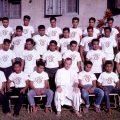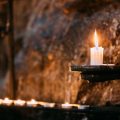How My God Has Changed
Black and White: The Faith of My Childhood
Once upon a time, my God was an imposing figure, important but one that remained outside my life except in those holy times and places reserved for him. He entered my life in mass and communion and in those other actions defined by the church as sacred: the sacraments, blessings and prayers. We all knew he loved us, but the love seemed to be both distant and conditional. We could hear his commanding voice beckoning us to stay away from sin and inviting us to move closer to him. God was something distinct from me and the rest of his creation, always summoning us to follow his standard. The sanctuary lamp in a dark church was a symbol of this God, a living presence in the house dedicated to him that was forever inviting us to recall his presence even after we left church.
Sharp distinctions were of great importance in the past: distinctions between God and his creation (no room here for pantheism), between good and evil, between saints and sinners, the blessed and the damned, the body and the soul, the worldly and the spiritual. Surely such clarity had its purpose. We were just beginning to find our way and needed such labels to maintain our course bearings on our perilous journey through life. So the choices in life between one road or another, between opposites, were marked out in large capital letters. My own vocation, I imagine, was partly rooted in the desire to follow the high road (religious life) as distinct from the merely ordinary path (life of a Christian layman), all of which was diametrically opposed to a life of egotism and worldly pleasure that we knew would lead to perdition.
Even as I was preparing to enter the Jesuits, however, I was introduced to Graham Greene’s work. During an illness in my senior year, a Jesuit scholastic sent me a copy of The Heart of the Matter—the tale of Scoby, an English bureaucrat in South Africa, who begins an affair with a lonely 19-year-old woman out of a mixture of lust and compassion. In the end, Scoby takes his own life because he cannot bear to hurt either his wife, who comes to visit him toward the end of his assignment, or God. “Was Scoby saved or not?” the Jesuit scholastic who lent me the book asked. When I shook my head emphatically and said that he couldn’t have been because suicide is a mortal sin, a memorable discussion followed. Suicide might be evil, my teacher suggested, but perhaps it is partly justifiable if done out of love. That led to other questions: Is Scoby a saint or a sinner? A martyr or a victim of his own lower feelings? The novel, like the rest of Greene’s works that acknowledge this messy world of ours, cuts through these easy distinctions. For me it was a moment of cognitive dissonance.
My world, and with it my understanding of God, had relied greatly on clear distinctions between polar opposites. Heaven and hell, the abodes of angels and demons, were at different ends of this universe. Similarly, sin came in two categories: mortal and venial. At bottom, all of us were bound by that logical premise known as the principle of contradiction: that is, nothing can be true and false at the same time. For one raised in this post-war Catholic culture years ago, it was reasonably easy to locate ourselves and others in this spiritual world of black and white contrasts. Or so we thought. Yet, the reality that I was beginning to encounter even in those early years, was taking on increasing shades of grey. Not yet fifty shades perhaps, but many.
Beyond “Either-Or” Thinking
In my early 20s, as I began a personal search through social sciences to find the more integrating vision I thought I needed, I discovered Mircea Eliade’s books on religious experience. Eliade, a historian of religion, identified what he regarded as the fundamental distinction between East and West. Western tradition, he claimed, was grounded in the “either-or” thought system characteristic of ancient Greek philosophy, whereas the Asian mentality was much more hospitable to “both-and” thinking. Even if Eliade’s framework itself, the duality between East and West, reflected the polarizing thought framework that the author was holding up for critique, his point seemed to be legitimate. The grand Asian religious systems do, in fact, seem to offer more room for “both-and” thinking. The first of Eliade’s books on religion, The Sacred and the Profane (whose title represents yet another dichotomy), proposes what he calls coincidentia oppositorum—the reconciliation of opposites. Even as the divinity can be both gentle and wrathful, creative and destructive, human life might be simultaneously filled with pleasure and pain, desire and repulsion.
Was the Western thought system I inherited, strongly reinforced by the spiritual beliefs that were an outgrowth of that system, thus shaping my vision of the world? Were we all losing the subtle hues to a classification system that was biased in favor of sharp contrasts? Surely modern communications began with the telegraph, which made use of pauses in electrical current that were patterned into dots and dashes. Is it too simplistic to suggest that the fundamental bias toward “either-or” has only increased in time? Indeed, the “0-1″ binary coding forms the basic structure of just about everything we hold dear in our computer age. Is it any wonder, then, that our spiritual world should have been classified the same way?
A regency assignment to Micronesia, with its opportunity to experience a Pacific Island culture, offered me another challenge to this dualistic thought system. Although I was puzzled by so much of what I went through during those three years, I left the islands to begin theology studies with the strong belief that the cultural boundary line that clearly separated the islands and my own society was by no means impenetrable. I had always felt a common humanity—some deeper linkage with the people I met in the islands than their strange customs would suggest. I knew that it might require considerable work to understand their cultural ways, but I had the confidence that in the end I’d find something foundational that would link us tightly.
That conviction has only deepened over time. Perhaps that’s why I’m incensed at the insistence of those who rally behind the flag of postmodernism, despite all the nuances that the ideology justifiably supports, proclaiming that “East is East and West is West, and never the twain shall meet.” Never will the unenlightened outsider come to an understanding of an exotic culture not his own, postmodernism seems to maintain. For me it is simply a latter-day insistence on still more unbridgeable distinctions, just like the ones that abounded in the old-fashioned church in which I was raised. Far from a newer and improved version of modernism, postmodernism appears to be a return to the age of comfortable distinctions, the walls that divide this from that, the triumph of the “either-or” over the “both-and.” I had been left to hope as I aged that those walls would come tumbling down, but clearly they had not.
The Battle between Competing Systems
Whether dualism (off-on, 0-1, up-down, in-out) is embedded into the deepest structure of the universe, we can agree that polarities are a useful device in describing the external world and our own inner life. The problem is not with our using them in this way, but in our failure to recognize the degree to which these polarities interpenetrate one another on the personal and spiritual level. Somehow, even as we compulsively attempt to sequester these polar opposites, we must acknowledge the uncomfortable fact that these opposites are ingredients in the untidy mix of life. We need our dichotomies, rooted as they are in our thought processes. Yet we also need to recognize that the grammar of “either-or” collapses in the deepest part of ourselves—the part in which mystery rather than reason reigns.
Perhaps those dichotomies that seemed to rule the world aren’t really as unbridgeable as I had once believed. Jesuits had a long and storied history of trying to bridge the “natural” and the “supernatural,” as I was beginning to appreciate. The best of Jesuit preaching and education was an attempt to discover how God—or the supernatural element, if you will—was at work in our world. Theologians as different as Karl Rahner and Theilhard de Chardin seemed to be trying to explain the interpenetration of the two realms in a way that might make sense even to a non-believer. There were other, competing voices, of course—the voices of those who insisted on the separateness of the two and argued for very clear distinctions between the good and the bad. In the aftermath of Vatican II during the 1960s theological battle lines were drawn up. Moral theologians joined the fray. Many of the latter argued for these clear and distinct principles, as if they needed not only guidelines for moral behavior, but the desperate assurance that those distinctions, learned from childhood, offered a lasting map of life.
In the rough-and-tumble life of teaching, study and ministry I’ve enjoyed since ordination nearly a half century ago, such hard and fast distinctions proved to be less than helpful. One day I might be speaking to fellow believers about faith and life, always trying to situate one in the context of the other. The next day I could be sharing personal reflections with agnostics and atheists and skeptics, always trying to learn from them while relating to them some of my own experience. How could radio evangelists (or hard-line Catholic pastors, for that matter) presume to sort out the sheep from the goats? What criterion was to be used? Surely not simply the declared church affiliation or lack of the same. Wasn’t our acknowledgment of not only “anonymous Christians” but even “secular saints” blurring the old distinctions we once made between the saved and the lost?
Furthermore, the type of work in which I was engaged—broadly ranging from public education to public ministry—seemed to encompass the secular as well as the sacred. Where exactly did one leave off and the other start? Mircea Eliade would have identified any formally religious activity as sacred, but he would have understood that its very purpose was to invest that “secular” part of our lives with sacral significance. As a priest, I would have been deeply disappointed to be told that school administration or academic research was purely a secular pursuit. I would have liked to believe that my work was intended to signify in some small way the love of God for his people, even the least significant of his people. Here again the old distinctions did not seem adequate to describe life as it was lived.
Is It Really God or Just Me?
All the while, the breakdown of those polarities went even deeper. I might have tried to assure myself that I was doing my work, whether it appeared secular or not, for the love of God. But was I? “I’m just trying to serve God,” I might tell myself as I forged on with some project, but I was always clearly conscious of the fact that I was serving myself as well. Often enough the work was inherently interesting, its completion satisfying, and the recognition from others rewarding. Attempting to untangle and identify the motives for much of the work I was doing in the hope of ascribing it to God or to myself was frustrating, perhaps even self-defeating. Another boundary broken down.
And still it goes on. As young Catholics, we understood that prayer was somehow a conversation with God. During what I call prayer, however, am I hearing echoes of my own voice or is it God who is talking? Or does it really make any difference, if we believe that the Spirit prays in us, as Paul suggests in his letter to the Romans? As we move forward, we begin to recognize that we are not really as much in control as we may have once thought. “Not I live, but Christ lives in me,” Paul again writes. As we become seasoned in prayer, do we surrender our independence, our individuality? Do we slowly over time become assimilated by the Other to whom we pay homage? Our ego asserts itself strongly enough at other times for us to appreciate the great distance between the self and the One we are supposed to be serving. Even so, in times of prayer at least, the distinction between my own inner voice and the Lord’s seems to shrink.
Thankfully, the tyranny of such distinctions and the hold they might have on thought and life only diminished as I grew older. On first reading that inspirational decree “The Identity of the Jesuit Today” from the 32nd General Congregation, I remember being jolted by those words in the opening paragraph that identified a Jesuit as one who “knows he is a sinner, yet called to be a companion of Jesus.” My earlier map had told me that “sinner” and “companion of Jesus” might describe the same person at different times in his life, but to use them simultaneously was a real stretch. The two would have belonged to different worlds, according to my earlier understanding. Now, in old age, I can assent to the statement much more comfortably. Even that distinction between saint and sinner has worn thin by this time. Scoby may well have joined the company of saints. The same might be said of my friends who, despite their alleged rejection of the faith, were willing to talk late into the night about their lifelong search for truth. That’s good news for those of us who haven’t always lived irreproachable lives.
Shrinking Distances
As we age, the world seems to collapse in on itself and on us. I find myself feeling more closely linked to others than ever before—even the “least of our brethren” When I use this phrase, I don’t mean mainly the poor or disadvantaged. I mean the ones who would have been my natural enemies at one time—the vain, the attention-seekers, the people who seem to script what they say in order to avoid bad publicity. In addition, those who throw out words of anger and apparent hatred at anyone they meet, the affluent who seem to have no time for anyone outside their narrow social circle, the up-tight as well as the promiscuous. I can feel sorry for them now in a way I never could before because I see what once I would have labeled “sin” to be an expression of their weakness. Like me, they know in their innermost heart that all is not right. Because they are like me, I can empathize with them and see them as brothers and sisters, even if they wear knives or carry guns. More boundaries being erased, I suppose.
Likewise, other distances shrink. God may still be God, but I no longer think of him as outside myself in the same way I used to when I was young. I see him as working to infiltrate my being, burrowing inside my head and heart to become a very part of my make-up. It’s nearly impossible for me to distinguish when I’m talking to him or to myself. I no longer worry about being accepted by him—I have come to take that acceptance for granted, even though I am more clearly conscious of the sinfulness that suffuses me. I don’t only or especially mean sinful acts or sinful intentions. I mean the sense of compromising and being compromised down to my core—the painful awareness of the privileged place of myself in my life despite the very real desire to hand over my life and all it might contain to God. The desire to surrender everything increases with age for me, but so does the awareness that I am stubbornly clinging to so much because I think I need it to make myself happy.
There are other corollaries of the movement away from “polar thinking.” We might honor the men and women who have statues to celebrate their lives and prayers to honor them, but I find myself with a newly acquired respect for the unheralded saints and mystics in the church and even outside of it. These people would never regard themselves as either, I know. They see themselves, I’m sure, as wounded soldiers still firing away on the battlefield of life. At best they might think of themselves as “wounded healers,” as Henri Nouwen calls them, or “sinful apostles.” Whatever they may call themselves, they are more of God’s chosen.
Boundaries bridged, dichotomies dissolved. That’s what happens as a person ages.






